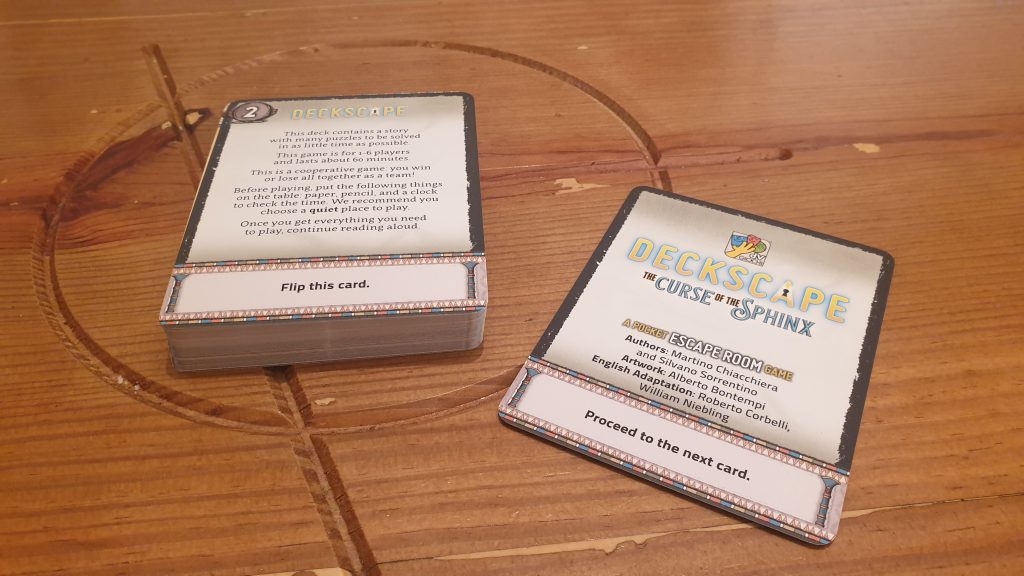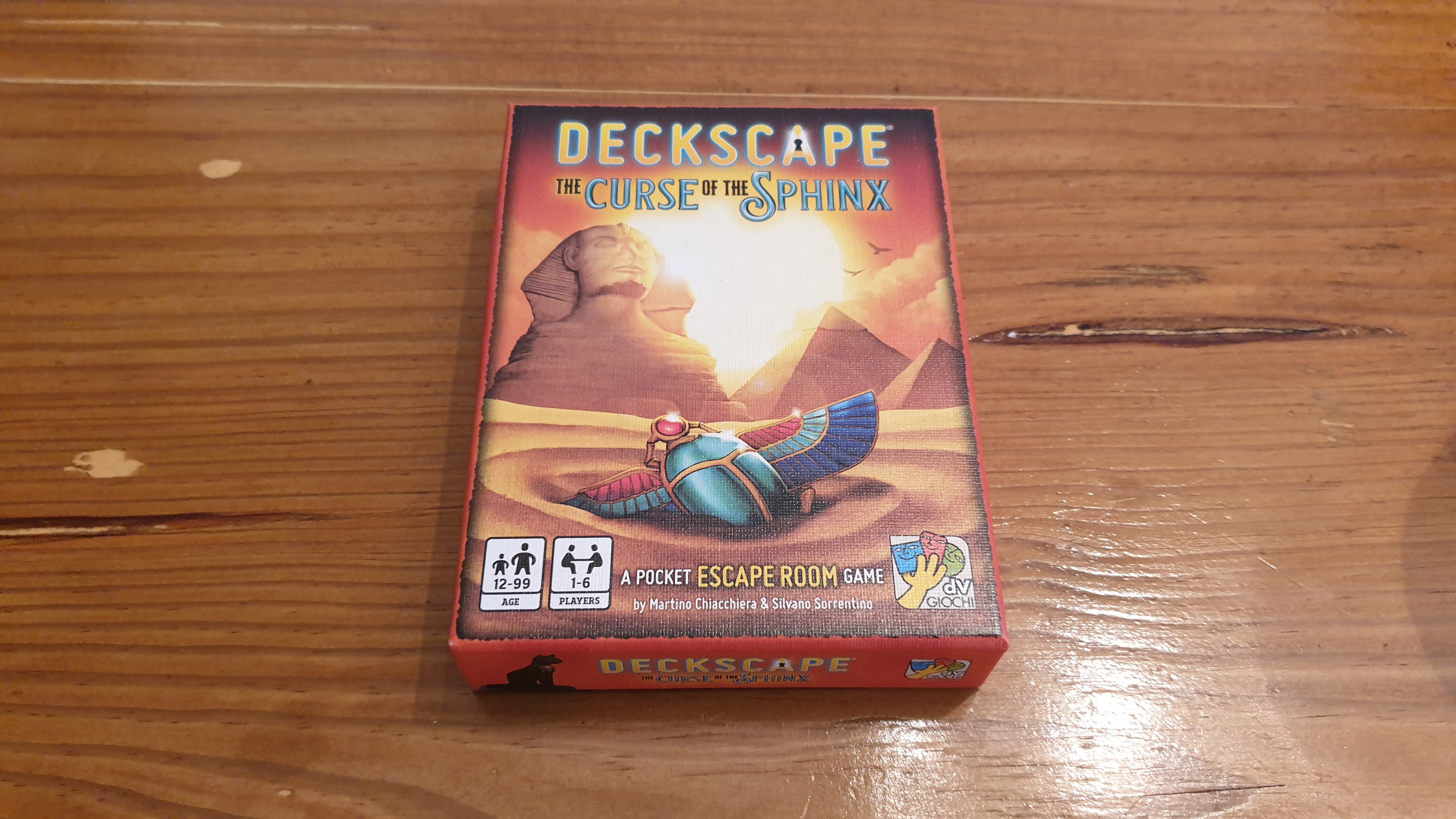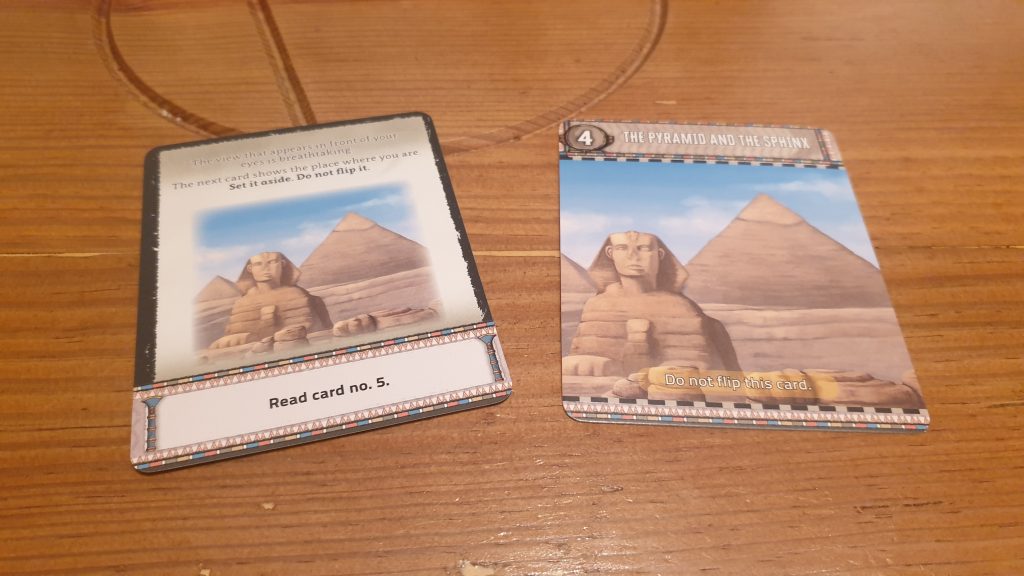Deckscape The Curse of the Sphinx is the latest escape room like cooperative card game from publisher dV Giochi. Designed by Martino Chiacchiera and Silvano Sorrentino, featuring artwork from Alberto Bontempi, this sixth installment sees 1 – 6 players stuck in Egypt for around an hour. Whilst visiting the ancient monuments players find themselves trapped in a secret room, with a mummy after them. However, does the excitement to escape reach the peaks of the Pyramids? Let’s find out!
Contained in the Deckscape The Curse of the Sphinx box is a single deck of cards. The cards are in a specific order, with warnings of which side up the deck should be and to not shuffle it. With no rulebook or setup to do the experience begins as soon as players turn over the first card. The first few cards explain how the game works, as well as a small warm up puzzle. Don’t worry until the game indicates players aren’t against the clock so it allows those new to the series to understand the way things work.
For the most part players are working together on a puzzle that is on one side of a card, with the solution on the other. At specific points in the journey however multiple puzzles may be available to solve simultaneously. When everyone agrees on the answer to a card it is flipped and regardless of being correct or incorrect the game, and narrative, continues.

In the other Deckscape titles whenever players get a puzzle wrong they obtain an X mark – losing the team time at the end of the game. X’s return in The Curse of the Sphinx but it isn’t instantly, with a small deck of cards seeing a Mummy advancing towards players. Thematically this works well, with there being nothing “better” to find walking towards you in Egypt. The small set of cards add interruptions and small side tasks that must be completed. They snap players heads out of the other puzzles. This isn’t in an annoying immersion breaking way, adding an interesting way to punish players for wrong answers.
The aim is a simple one get through the deck of cards with as few penalties as possible. Of course, in practise this isn’t easy. The difficulty normally present in the Deckscape titles has seemingly been ramped up for The Curse of the Sphinx. For the first time we had to utilize the clue card multiple times throughout the experience. Then, even when equipped with the clue some of the puzzles left us stumped. This inevitably meant that the length of the game was longer.
Whilst previous iterations were completed in around an hour after calculating the X marks, The Curse of the Sphinx actually took in real time an hour and 10 minutes. This will vary from group to group, as will the amount of time players are happy to stare at a puzzle until they make a breakthrough. Still, it is the first that has lasted as long.
Perhaps due to the difficulty, The Curse of the Sphinx seemed to have more puzzles where players had to think outside of the box. Whilst there is nothing wrong with this, when to and when not too is never exactly clear. When any wrong answer, regardless of why, will see the mummy advance or an X mark received, this can feel punishing. A light spoiler here: One specific puzzle we had discussed the correct way to complete the puzzle but dismissed it as the card mentioned nothing about allowing re-orienting cards.
At another point players may try to think out of the box like this and be wrong, so the balance seemed a little off. This has been present in other Deckscapes but when you get more wrong the irritation builds up. This stems from the fact that there isn’t the ability for trial and error in the way Deckscape is designed – it helps the simplicity of play but can make it more punishing. Players are simply right or wrong with no middle ground, or opportunities to be close enough.
Deckscape may literally be a deck of cards but there is still plenty to commend production wise. The cards are far from small meaning all of the text on them is of decent, legible size. When players are asked to split the deck out the cards are colour coded to make this a simple exercise. Finishing them off nicely, is some solid artwork that all fits the Egypt theme, in the cartoon Deckscape style.
Players can jump straight into the series with Deckscape The Curse of the Sphinx, as each is a standalone adventure. The Egyptian theming is there, making the title visually different. Nevertheless, while the puzzles use hieroglyphs in parts they could be any symbol. The usage of the mummy chasing players down does offer a different type of punishment for incorrect answers, which worked well to make this adventure stand out. Still, from the difficulty of play this is perhaps not the best place to jump into the series, with Heist in Venice or El Dorado the better starting points and The Curse of the Sphinx then ready to challenge players down the line.
[Editor’s Note: Deckscape The Curse of the Sphinx was provided to us at Essen Spiel 2019 by dV Giochi for the review.]



